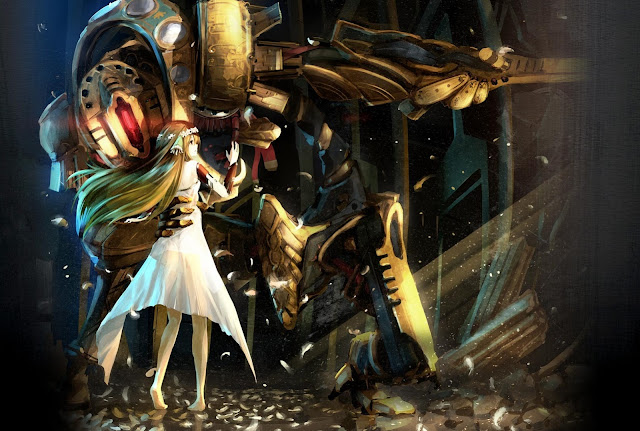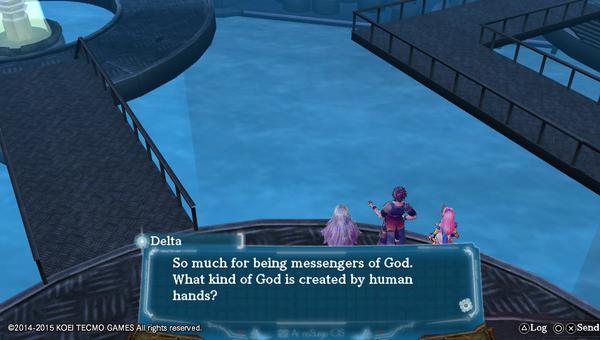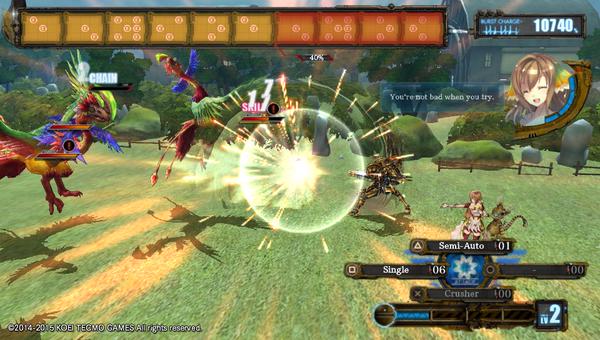Within the complex dual-narrative science fiction epic structure that marks Ar nosurge’s story lies something so gentle, delicate and vulnerable that it’s almost uncomfortable to witness. As easy as it is to get distracted by the anime game tropes, frequent comedy digressions and genuinely unique combat system, this is a game that has a very simple, honest, and heartfelt core: it’s a story of relationships and love, and the way it explores this theme is subtle, nuanced, and ethereal.
Related reading: You can also check out Jedediah’s review of the PlayStation 3 release from last year.
It takes some work to dig down to that core, though. Ar nosurge presents players with a dual-narrative structure, which means you’ll be swapping between two couples of protagonists, worlds apart, as a grander narrative unfolds between the actions of both of them. On the one hand are Delta, Casty (Cass), and their allies. These are a group of humans who exist within a walled city, called Felion, and fight to protect the wall from being breached by aggressive-but-intelligent elemental beings called Sharl, as well as their robot minions. On the other hand is the story of Earthes, a robot with a human personality, and Ion, his creator (he’s an identifiably male robot), as they embark on a quest to prevent an acquaintance of Ion’s from snuffing out all existence.
The storytelling itself is often messy. Filled with assumed knowledge (of a game called Ciel nosurge, which was never actually released in English), Ar nosurge is so filled with a love for its own lore that it can be difficult to follow along with at first, and is so focused on its broader narrative that it really doesn’t concern itself with addressing the many inconsistencies and discrepancies it’ll throw at you. Just to give you an example: when we first meet Ion, she is a prisoner of a virtual world, and is being kept there by an AI system called Nelico. But despite being a bit of software, Nelico keeps showing up, even after Ion escapes to the real world. The explanations for this are laboured and only start to make sense as the game starts drawing conclusions (at which point you’ll realise there is more to Nelico than you’ll initially told), but it’s an example of the habit Ar nosurge makes of hitting players with stuff that doesn’t make any obvious logical sense at first, before slowly explaining itself much later on. It there is anything to fault about Ar nosurge, it’s that its basic-level storytelling is far too ambitious, and it might lose some players before they get far enough into it for it to all make sense as a consequence.
But then it probably had to be written this way, because the thematic underpinnings of the game are incredibly complex and numerous, and ambition is hardly a bad thing when it results in something this rewarding. This is a game of heavy symbolism and metaphor, making it almost poetic in the way it can be unpacked and interpreted. To use the aforementioned scene as an example of the broader narrative experience; Ion escapes from her virtual prison by blowing up a massive wall, discovering that behind the wall is actually a staging area, like you would see behind a film set or the curtain at a theatre production. Ion realises that her world is a fabrication designed explicitly to keep her both happy and ignorant of what is going on around her. It’s a real red pill/ blue pill moment, and was designed explicitly to set up the concept of “walls” as something hiding an inconvenient, but important truth. From there, upon the realisation that each character has their own personal walls, you’re led to start questioning the truth of – and the nature of the existence of – each and every character.
You can’t write an existentialist narrative without guaranteeing that you’re going to confuse a bunch of your audience, so kudos to the team at Gust for having the bravery to tackle the subject. But that’s not all. Ar nosurge also regularly raises themes of environmentalism, and the impact that humans have on their environment is the subject of sharp commentary throughout the game. “Desperate to survive, we destroyed all life other than our own. Even of the planet that had loved us,” said Zill, one of the supposed lead villains. “They will learn love for their planet by becoming the grass, trees and water. Their souls will become pure,” said Kanon, another ‘villain.’ We’re not meant to necessarily sympathise with these enemies… at least, at first. It should come as no surprise that their motivations are shown to be far more complex the further through the narrative you work, and the unbending extremes that these villains go to to further their agendas in their roles as heads of religious orders forms another, separate, criticism of religious dogma, but the environmentalism, tinged with just a hint of nihilism, is a rich theme that is certainly pertinent to our real lives and the debates around climate change vs. human exploitation of the environment.
The above are just two directions you can go were to you study Ar nosurge at a deeper level. There are plenty of others. That’s why the story is so fundamentally confusing at times; it has so many dense, heavy balls in the air at times that it’s inevitable that there will be moments where it drops one (or them all). But for the most part the game juggles it all with panache and sensitivity. This is not a game of instant gratification, nor is it one that can be fully comprehended on one play through, but as with some of the most intelligent games released in recent years (Nier, Danganronpa), it’s an intensely rewarding game to go the extra mile and try to understand.
Such is the density of the ideas that the game has going for it could also be as alienating and cold as a philosophy thesis, but the real genius here is that it is anything but. Ar nosurge is a beautifully emotive game, and that’s because sitting on top of its philosophical and narrative underpinnings is a very simple theme; it’s a game about relationships.
A core mechanic of the game is that both lead male characters can enter the souls of the female characters. There, they can interact with shards of the character’s persona, and participate in their internal conflicts. These sections play out like a visual novel, and through them the male characters come to understand the fears, motivations, and personalities of the various female characters. Multiple characters can be explored this way, but the central purpose to doing so is so that Earthes and Delta can form a tighter and more meaningful bond with Ion and Cass, respectively. This makes them a more effective fighting combination by providing them with perks to take into combat, but more importantly, through this system we see a genuine exploration of the bonds that tie two people together.
Key to this theme is the concept of vunerability. While inside the girl’s souls, Delta and Earthes need to break down metaphoric walls (see, walls are a recurring motif in this game) that the girls put up to hide their weaknesses and fears from the world. The characters then power up by sharing a bath, in which they physically expose themselves to one other. The exploration of one another, both physically and emotionally, is what makes a bond between two people grow and develop, and in playing through Ar nosurge there is an almost poetic – and very noticeable – deepening of relationships between each of the characters.
It’s not perfect – the exploration is very one-sided, for example, with the girl not being able to reciprocate by entering the male’s souls, and I’m sure there’s been some criticism of the game in some circles as a consequence. But while it’s not perfect, it’s a genuine and honest attempt at doing meaningful and deep characterisation, and it works; there is real emotional gravitas within Ar nosurge. The realisation that the bond between characters is such that they cannot function properly without the other is a compelling commentary on the strength of real relationships, and comes with it the understanding that while the male characters are the physical force and are literally protecting the women, it is the women with the internal strength that ends almost each conflict within the game. Neither gender is given a position of privilege in Ar nosurge, despite what initial appearences might suggest, and Gust remains one of the most sensible and progressive development studios working on games for Japan’s fan cultures.
The emotional weight of the game’s relationships is backed by Gust’s typical mastery of presentation and sense of artistry. Ar nosurge is a budget production and doesn’t look great on Vita thanks to the small screen, as enemies in battle are too small and the camera is zoomed out too far to really appreciate the finer details of the environments. Despite that there’s a graceful beauty and consistency to the aesthetics that really develops and flourishes the further on the game goes. The emotional weight of interactions is also complemented by one of the most heartfelt and resonant soundtracks I’ve ever heard. The beautiful melody by (the now sadly deceased) Origa (above) had me tearing up for how well it was matched with the dialogue of its scene.
It’s perhaps not surprising that the game exhibits such a mastery of music, given that its director, Akira Tsuchiya, is one of the rare examples of a sound designer that moved through the ranks to lead game development projects. And given that it’s probably not surprising that Ar nosurge’s combat system itself is, in an abstract sense, musical. In each battle, characters square off against a small group of enemies that, upon defeat, are immediately replaced by another small unit. The player controls the male hero (Earthes or Delta) as they physically attack these enemies and protect the female (Cass or Ion) as they start singing. The flow of these enemies mimics the movement from one bar of music to the next, and as groups are defeated, a percentage meter slowly fills up. Once it hits 100 per cent, Cass or Ion can belt out what acts like a chorus, which wipes out every enemy unit and ends the battle.
It’s a battle system that is both unique and interesting. Unfortunately it’s also placed within a game that isn’t that interested in combat. With so much narrative and character exploration, and such a minimal effort placed into providing players with physical areas to explore, actual battles take place far less often than in most JRPGs, and characters level up after almost every battle in order to keep the progression rapid enough that the bosses can be of escalating difficulty.
Furthermore, the difficulty of battles is pitched quite low. You can challenge yourself to an extent with a higher difficulty setting, but really, Ar nosurge wants to you become invested in the characters and their relationships, not the way they beat up on monsters and machines. The combat seems to be thrown in as an afterthought to appease the marketers (i.e. “there’s no way we can sell a visual novel, make it a JRPG!”), which is a real pity, because Ar nosurge’s combat system, were it more of a core focus, would be the kind of system that almost any other JRPG developer out there would have fallen over themselves to implement in their own games.
For all that I’ve written above, it’s also worth noting that Ar nosurge isn’t a dirge of a game, and for all its dark themes it also has a genuine sense of humour. The little dance that characters do when synthesising items could be taken straight from the “weirdest Japanese TV ads you’ve ever seen” YouTube channels, and provides some wonderful levity to the game. Some of the cut scenes and fan service moments also help to ground the game as something that’s still entertaining, for all the serious commentary and thematic exploration that it gets up to. The result is a game that has more personality than many other philsophically-dense games and is in some ways similar to Persona 4 as a result.
Related reading: An interview with the director of Ar nosurge: Part 1 and Part 2.
And that’s why Ar nosurge has instantly become one of my favourite games of all, up there with the likes of Nier and Persona 4. Even when it’s not at its best, it’s still better than almost anything else. Emotional and poetic, deep and intelligent, it’s the kind of game that will fly under most people’s radars, but it’s also one of those games that will hold a place of pride in the libraries of those that are lucky to discover it. This is a game you will hear me celebrating for many years to come.
– Matt S.
Editor-in-Chief
Find me on Twitter: @digitallydownld












The links to the interview give a 404 error.